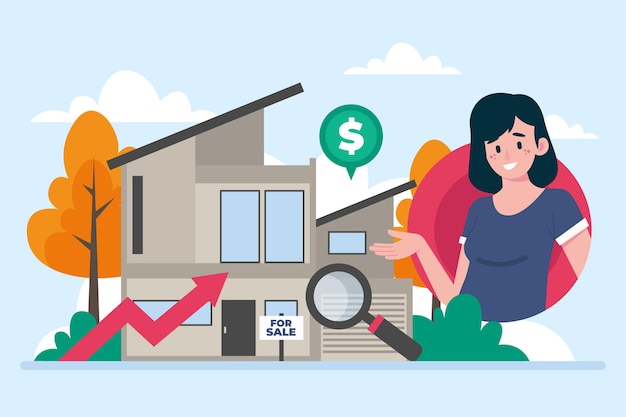Understanding Existing Home Sales
In today’s dynamic real estate landscape, the realm of property transactions continues to evolve at a rapid pace. It is imperative to stay informed about the latest shifts and patterns in the market, as this knowledge can empower buyers, sellers, and investors alike to make informed decisions. This article aims to shed light on the essential details and emerging trends in the domain of existing residential property sales, providing valuable insights that can shape your real estate goals.
By delving into the nuanced world of home transfers, we gain a deeper understanding of the intricate factors that drive this segment of the market. We explore the statistical data, examine the undercurrents shaping buyer behavior, and consider the wider socioeconomic trends influencing the housing industry. Through these analyses, we aim to equip readers with a comprehensive understanding of the key forces at play and forecast potential future developments in residential property sales.
Unveiling the Dynamics of Existing Home Transfers
Within the realm of property sales, existing home transfers occupy a significant position. These transactions involve properties that have previously been occupied, providing buyers with the opportunity to invest in a dwelling with a distinctive history. Understanding the dynamics of existing home transfers is crucial for comprehending the ebb and flow of the housing market. By uncovering the motivations, preferences, and strategies of both buyers and sellers in this particular segment, we can decipher the factors that contribute to its growth and stability.
Unearthing Patterns and Opportunities
Through a careful analysis of the data, we can begin to identify patterns and opportunities within the existing home sales market. This analysis allows us to discern the average days on the market for different property types, the regions that demonstrate sustained demand, and the factors that influence pricing trends. Armed with this knowledge, prospective buyers can strategically navigate the market, and sellers can capitalize on emerging trends to optimize their sales strategies. We aim to distill these patterns and opportunities into actionable insights that can guide your decision-making process in the realm of residential property transfers.
Market Overview
The Market Overview section provides a comprehensive analysis and understanding of the current state of the real estate market. This section aims to offer a general perspective on the key aspects and trends impacting the buying and selling of properties, without resorting to specific terminology.
Current Market Conditions
Examining the present conditions of the market is crucial in comprehending the dynamics of the real estate industry. This section focuses on a wide range of factors such as supply and demand, pricing, interest rates, and economic indicators that influence the buying and selling of homes.
Market Trends
Tracking and analyzing trends in the real estate market provide valuable insights into the behavior and preferences of home buyers and sellers. This section explores various trends, including housing preferences (such as suburban vs. urban living), demographic shifts, technology’s impact, and the influence of environmental factors on the market trajectory.
- Regional Highlights
- Economic Factors Influencing the Market
- Impact of Government Policies
- Emerging Market Opportunities
- Changes in Financing Options
- Shifts in Buyer and Seller Behavior
By examining market conditions, analyzing trends, and understanding regional and economic factors, readers can gain a comprehensive understanding of the existing home sales market. This knowledge is crucial for making informed decisions when buying or selling properties.
Factors Influencing Home Sales
When it comes to the dynamic and ever-changing real estate market, there are several factors that play a crucial role in influencing home sales. These factors encompass a wide range of elements, including economic conditions, market trends, and buyer preferences. By understanding and analyzing these factors, homeowners, real estate agents, and investors can gain valuable insights to make informed decisions.
Economic Conditions
One of the primary driving forces behind home sales is the overall economic conditions of a region or country. Factors such as employment rates, income levels, and interest rates greatly influence the buying power of potential homebuyers. When the economy is flourishing with low unemployment rates and rising incomes, individuals are more inclined to purchase a home. Conversely, during times of economic uncertainty, such as recessions or high unemployment rates, home sales typically decrease as potential buyers may delay their purchasing decisions.
Market Trends and Demographics
Understanding market trends and demographic shifts is crucial for comprehending the factors that influence home sales. Market trends refer to the fluctuations in supply and demand for real estate properties. When there is a high demand for housing and limited inventory available, it often results in increased competition among buyers and a higher likelihood of quick home sales. Demographics, on the other hand, involve the statistical characteristics of a population, such as age, income, and household size. Demographic shifts, such as an increase in young families or retirees, can significantly impact home sales by altering buyer preferences and housing demands.
| Factors Influencing Home Sales |
|---|
| Economic Conditions |
| Market Trends and Demographics |
In conclusion, various factors, including economic conditions, market trends, and demographics, play a vital role in influencing home sales. By staying knowledgeable and adapting to these factors, individuals involved in the real estate market can make strategic decisions to maximize their success.
Regional Variation in Residential Property Transactions
Residential property transactions across different regions exhibit distinct patterns and trends, highlighting the diverse dynamics of the real estate market. This section provides an overview of the regional variation in existing home sales, delving into the unique factors that contribute to the disparities in transaction volumes and prices.
Factors Influencing Regional Variation
Several factors play a significant role in driving regional variation in residential property transactions. Economic conditions, population demographics, local job markets, and urban development policies are just a few examples of the multitude of variables that shape the real estate landscape.
Distinct regional economic conditions impact the demand and supply dynamics of residential properties. Strong employment growth, favorable business climates, and robust economic activity often result in higher demand, leading to increased transaction volumes and, at times, rising prices. On the other hand, regions facing economic challenges, such as high unemployment rates or stagnant job markets, may experience lower demand and subsequently witness a decline in home sales.
The demographic composition of a region also influences residential property transactions. Factors such as population growth, age distribution, and migration patterns shape the demand for housing in different locations. Regions with a significant influx of young professionals may experience increased demand for starter homes or apartments, while areas with a higher proportion of retirees might have a higher demand for retirement communities or assisted living facilities.
Local job markets, including the presence of major industries or the growth of specific sectors, can impact the demand for housing in different regions. Areas with thriving job markets in technology, finance, or healthcare are likely to attract a greater number of homebuyers, resulting in higher transaction volumes. Conversely, regions experiencing job market declines or shifts in industry composition may witness a slowdown in home sales.
Regional Variation in Transaction Volumes and Prices
The regional variation in existing home sales is evident in the divergent trends observed in transaction volumes and prices across different areas. Some regions experience strong demand and limited housing supply, leading to competitive bidding and higher transaction volumes. This high demand often translates to increased market prices, making it a sellers’ market. In contrast, other regions may witness a surplus of inventory or conditions favoring buyers, leading to lower transaction volumes and relatively stable or declining prices.
Understanding the regional variation in existing home sales is crucial for homeowners, investors, and policymakers alike. It allows stakeholders to identify market opportunities, devise appropriate pricing strategies, and implement targeted policy interventions to address specific challenges in different regions.
| Region | Transaction Volume | Price |
|---|---|---|
| Region A | High | Increasing |
| Region B | Moderate | Stable |
| Region C | Low | Decreasing |
Impact of Interest Rates on Home Sales
The influence of interest rates on the real estate market is a crucial factor that significantly affects the buying and selling of residential properties. Fluctuations in interest rates can lead to noteworthy shifts in the demand and affordability of homes. Thus, comprehending the impact of interest rates on home sales is essential for understanding the dynamics of the housing market.
When interest rates are low, prospective buyers tend to be more willing to invest in purchasing properties. Low rates imply that borrowing money for a mortgage is more affordable, which increases the purchasing power of buyers. This, in turn, stimulates the demand for homes and drives up the sales in the real estate market.
Conversely, when interest rates rise, the cost of borrowing money becomes higher. This creates a deterrent effect on potential buyers, as higher rates mean increased monthly mortgage payments. Consequently, the higher financial burden may discourage some buyers from entering the housing market or cause others to reconsider their purchasing decisions. As a result, home sales might experience a slowdown during periods of higher interest rates.
It is worth noting that the influence of interest rates on home sales extends beyond the ability to afford a mortgage payment. The perception of future interest rate trends can also impact buyer behavior. Buyers who anticipate rising interest rates may feel a sense of urgency to purchase a property before rates climb further. This anticipation can lead to an increased demand and higher sales in the short term. On the other hand, buyers who expect interest rates to decline may defer purchasing decisions, waiting for more favorable borrowing conditions.
In conclusion, interest rates play a critical role in shaping the trends and patterns of home sales. Fluctuations in rates can significantly impact the demand for properties and the affordability of mortgages. Therefore, monitoring and analyzing interest rate movements is crucial for gaining insights into the dynamics of the housing market and making informed decisions within the real estate industry.
Emerging Trends in Homebuyer Preferences
In this section, we explore the latest developments and shifts in the desires and priorities of individuals looking to purchase a new home. As the housing market continues to evolve, it is essential to understand the emerging trends that are shaping homebuyer preferences, allowing industry professionals to stay ahead and cater to the evolving needs of potential homeowners.
1. Evolving Neighborhood Preferences
One notable trend revolves around the changing preferences for neighborhoods among homebuyers. Today, individuals are placing increasing importance on communities that offer a blend of convenience, accessibility, and a strong sense of community. Factors such as proximity to amenities, transportation links, schools, and recreational facilities are becoming significant determinants in the decision-making process.
Furthermore, homebuyers are seeking neighborhoods that embody sustainability and eco-friendly practices. They are looking for homes in areas that promote green spaces, energy-efficient features, and sustainable infrastructure, reflecting a growing commitment to environmental responsibility.
2. Technological Integration and Smart Homes
The emergence of smart home technology has revolutionized the way individuals perceive and interact with their living spaces. As a result, homebuyer preferences are increasingly focused on properties equipped with advanced technological amenities. Features like smart thermostats, automated lighting systems, and integrated security systems have become significant selling points for modern homebuyers.
Moreover, the integration of technological advancements extends beyond individual properties to encompass entire neighborhoods. Homebuyers are seeking communities that offer cutting-edge infrastructure, such as high-speed internet access, electric vehicle charging stations, and smart city initiatives, all of which contribute to a more connected and futuristic living experience.
These emerging trends in homebuyer preferences indicate a shift towards an emphasis on sustainable, technologically advanced, and community-driven living environments. By embracing these evolving preferences, industry professionals can position themselves as leaders in the market and effectively cater to the needs of prospective homebuyers.
Future Outlook for Sales of Previously Owned Residential Properties
Exploring the potential trajectory of the market for pre-owned residential properties
Factors Influencing Future Trends
Several factors have the potential to shape the future landscape of sales for previously owned residential properties. Economic indicators, such as mortgage interest rates and employment rates, play a significant role in determining the level of activity in the housing market. Additionally, demographic shifts, including changes in population size and composition, can impact the demand for existing homes. Policy changes related to government regulations and taxation policies also have the potential to influence the future outlook for sales of pre-owned homes.
Anticipated Market Performance
Based on current market trends and the aforementioned factors, experts predict a steady growth in sales of previously owned residential properties. The ongoing low mortgage interest rates are expected to continue attracting homebuyers, leading to increased activity in the market. Furthermore, the effects of demographic changes, such as the entry of millennials into the housing market, are anticipated to contribute to a sustained demand for existing homes. While certain areas may experience localized fluctuations, overall market performance is projected to remain positive.
| Key Indicators | Expected Impact |
|---|---|
| Mortgage Interest Rates | Low rates likely to stimulate homebuyer interest |
| Employment Rates | Stable employment market supports homebuying power |
| Demographic Shifts | Increased demand from millennials and other demographic groups |
| Policy Changes | Potential impact on market dynamics |
Q&A: Existing home sales
What are the key information and trends in existing home sales?
The key information and trends in existing home sales include the number of homes sold, the average sale price, the time homes spend on the market, and the inventory levels. These factors help gauge the current state of the housing market and can provide insights into buyer and seller behaviors.
How does the number of homes sold affect the existing home sales market?
The number of homes sold is a crucial indicator of the health of the existing home sales market. Higher sales volume typically indicates a strong market, while a decline in sales may indicate a slowdown or stagnation. Tracking the number of homes sold helps both buyers and sellers understand the level of competition they may face.
What role does the average sale price play in existing home sales?
The average sale price provides valuable information about the value of homes in the existing home sales market. An increase in average sale price typically suggests rising demand and limited supply, while a decrease may indicate a softening market. Buyers and sellers can use this data to determine appropriate pricing strategies.
Why is the time homes spend on the market important in existing home sales?
The time homes spend on the market is a crucial factor in understanding market conditions. If homes are selling quickly, it typically signifies high demand and a competitive market. Conversely, if homes are sitting on the market for extended periods, it may indicate a slowdown or an oversupply of homes. Understanding the average time on market helps buyers and sellers set realistic expectations.
How does inventory level impact existing home sales?
Inventory levels play a significant role in existing home sales. A low inventory of homes for sale drives competition among buyers and may lead to higher prices. On the other hand, a high inventory of homes can give buyers more choices but may also indicate a slower market. Monitoring inventory levels helps both buyers and sellers stay informed about market conditions.
What are the key trends in existing home sales?
The key trends in existing home sales include a surge in demand due to low interest rates, a shortage of inventory, and rising home prices. Additionally, there has been a shift towards remote work, which has increased the appeal of suburban and rural areas.
What are existing-home sales?
Existing-home sales refer to the completed transactions of already constructed homes, including single-family homes, townhouses, condominiums, and co-ops.
How are existing-home sales expected to change in 2024?
In 2024, existing-home sales are projected to fluctuate based on factors such as mortgage rates, housing supply, and economic conditions, as forecasted by industry experts like the National Association of Realtors (NAR).
What role does the National Association of Realtors (NAR) play in real estate?
The National Association of Realtors (NAR) is a trade organization that represents real estate professionals in the United States, providing resources, data, and advocacy for its members.
How did existing-home sales perform in 2023 according to NAR?
In 2023, existing-home sales experienced various trends influenced by changing mortgage rates, economic factors, and housing inventory levels, as reported by the NAR.
What is the median price in the context of existing-home sales?
The median price in existing-home sales represents the midpoint value of homes sold, where half of the homes sold for more and half sold for less.
What are pending home sales?
Pending home sales refer to transactions where a contract has been signed but the sale has not yet closed, indicating future activity in the housing market.
How do mortgage rates impact existing-home sales?
Mortgage rates significantly affect existing-home sales by influencing the affordability of home loans, with higher rates potentially decreasing buyer demand and lower rates potentially increasing it.
What is the difference between single-family homes and condos in existing-home sales data?
Single-family homes are standalone houses designed for one family, while condos are individual units within a larger building. Both are included in existing-home sales data but often show different market trends.
What does seasonally adjusted mean in real estate reports?
Seasonally adjusted data in real estate reports account for typical seasonal variations in the housing market, providing a clearer picture of underlying trends by smoothing out fluctuations.
How does the census impact data on existing-home sales?
The census provides demographic and housing data that inform existing-home sales trends, helping to understand market demand, population shifts, and housing needs across different regions.



